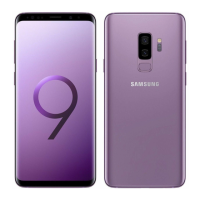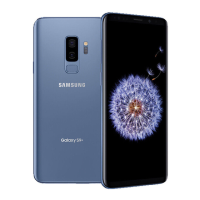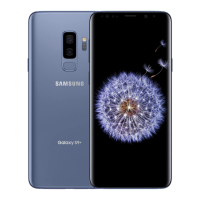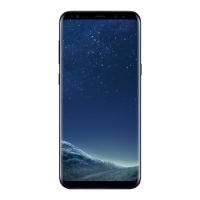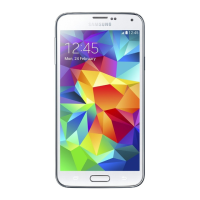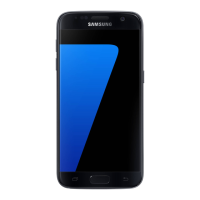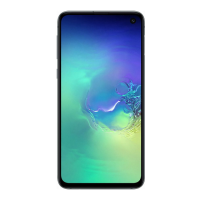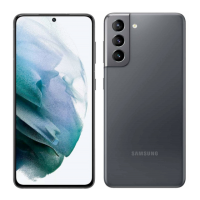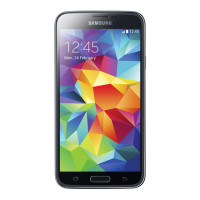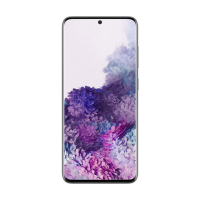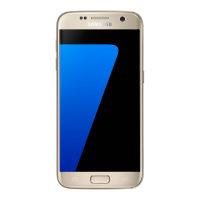Do you have a question about the Samsung SM-G9600 and is the answer not in the manual?
Important information before using the device for safe and proper operation.
Explains causes of device heating and provides solutions to prevent it.
Details the physical layout and basic functions of the device.
Visual guide to the device's external components and their labels.
Instructions and precautions for charging the device's battery.
Guide on how to install and manage SIM or USIM cards in the device.
Information on installing and using memory cards with the device.
Steps for powering the device on, off, and restarting it.
Procedures for setting up the device for the first time after purchase or reset.
How to register, sign in, and manage your Samsung account.
Methods for restoring data from another device or Samsung Cloud.
Explains how to control the touchscreen and its gestures.
Details the functions and customization of the device's navigation bar.
Overview of the Home screen and Apps screen interface elements.
Explains common icons found on the status bar for system indicators.
How to lock the screen and change screen lock methods.
How to open and use the notification panel for alerts and quick settings.
Information on keyboard layout, functions, and changing input languages.
Guide to downloading, installing, and removing applications from the device.
Introduction to Bixby features like Home, Voice, and Vision for device interaction.
How to use audio accessories with the device, including launching Bixby Voice.
Using Bixby Vision to identify objects, translate text, and search for information.
How to create and manage reminders for events and tasks.
Functions for making and answering calls, managing contacts, and call logs.
How to add, import, sync, search, and manage contacts on the device.
Guide to sending, viewing, and managing text messages and My Emoji stickers.
Browsing the web, using secret mode, and managing browser settings.
Setting up email accounts, sending, and reading emails.
Taking photos and recording videos using various shooting modes and settings.
Creating and using My Emoji and Live stickers for photos and videos.
Features for displaying information on the screen when it's turned off.
Customizing and using Edge panels for quick access to apps and contacts.
Running two apps simultaneously in split-screen or pop-up view.
Setting up and using Samsung Pay for secure mobile payments.
Managing wearable devices connected to the smartphone.
Accessing support, submitting feedback, and community features.
Creating and managing notes, including text, images, and voice recordings.
Creating and managing events and tasks in the device's planner.
Managing wellness and fitness goals, tracking progress, and health tips.
Recording voice memos, converting speech to text, and managing recordings.
Accessing and managing files stored on the device and in cloud services.
Setting alarms, using the world clock, stopwatch, and timer functions.
Performing calculations with basic and scientific calculator functions.
Listening to FM radio stations and scanning for available channels.
Organizing and launching games, and optimizing performance for gaming.
Connecting and controlling smart devices, home appliances, and IoT products.
Sharing images and files using various methods like messages, email, and Wi-Fi Direct.
Using the smartphone as a computer by connecting to an external display.
Connecting the smartphone to a TV or monitor via HDMI for presentations or media.
Overview of essential Google applications like Chrome, Gmail, Maps, and Drive.
Customizing device settings for personalization and configuration.
Managing Wi-Fi, Bluetooth, Data usage, and Flight mode settings.
Pairing and connecting with Bluetooth devices for data exchange.
Reducing data usage by limiting background app data consumption.
Reading NFC tags and making payments using the NFC feature.
Sharing the device's mobile data connection with other devices.
Activating and customizing settings for SIM or USIM cards.
Customizing settings for Nearby device scanning, Printing, and MirrorLink.
Faster downloads using Wi-Fi and mobile networks simultaneously.
Adjusting sound modes, ringtones, notification sounds, and vibration settings.
Configuring notification settings for each app, including icon badges.
Adjusting brightness, font size, screen mode, and resolution settings.
Reducing eye strain by limiting blue light emission from the screen.
Selecting screen modes like Adaptive display for optimal viewing.
Changing the display resolution to balance quality and battery consumption.
Setting up images to display as a screensaver when the device is charging.
Customizing device appearance with wallpapers, themes, and icons.
Activating and configuring features like Smart stay, Game Launcher, and One-handed mode.
Installing and using a second instance of messaging apps for multiple accounts.
Checking device status (battery, storage, security) and optimizing performance.
Managing battery power, power saving modes, and charging options.
Adjusting device performance settings for gaming, entertainment, or battery saving.
Checking and managing internal memory, residual files, and app storage.
Scanning the device for malware and checking its security status.
Managing installed applications, their settings, permissions, and uninstallation.
Securing the device with screen lock types, Smart Lock, and Find My Mobile.
Setting the device to unlock automatically in trusted locations or with trusted devices.
Unlocking the screen using face and iris recognition for enhanced security.
Setting up and using facial recognition to unlock the device.
Setting up and using iris scanning for device unlock and authentication.
Registering and using fingerprints for device unlock and app authentication.
Creating a secure, private storage area for apps and content.
Managing Samsung Cloud, accounts, and data backup/restore via Smart Switch.
Backing up and restoring device data to Samsung Cloud for safekeeping.
Transferring data between mobile devices using USB or wireless connections.
Configuring settings to improve device usability for users with impairments.
Customizing system settings, language, date/time, and device reset options.
Updating device software via FOTA service and scheduling updates.
Accessing help information for using the device and its features.
Viewing device information such as status, legal, software, and battery details.
Features to enhance device usability for users with vision, hearing, or dexterity impairments.
Adjusting screen zoom, font, and contrast for better visual clarity.
Features for sound detection, light notifications, and adjusting sound balance.
Customizing input methods like universal switch, assistant menu, and cursor control.
Configuring speech settings for Voice Assistant, including language and rate.
Quickly opening accessibility menus by pressing hardware keys.
Setting up quick shortcuts for accessibility features using key combinations.
Setting alerts for unread notifications and customizing reminder intervals.
Saving, importing, and sharing accessibility settings files for backup or transfer.
Solutions for common device issues like codes, network errors, and power problems.
Troubleshooting poor network connectivity or audio quality issues.
Solutions for issues related to the device not charging properly.
Troubleshooting common error messages when using the camera app.
Tips for improving photo quality when it appears poorer than the preview.
Troubleshooting common Bluetooth connection and performance issues.
Tips for freeing up device storage space by deleting unnecessary data.
Troubleshooting steps when Bixby Voice is not responding or functioning correctly.
Solutions for issues where the device fails to recognise irises from the locked screen.
Important information before using the device for safe and proper operation.
Explains causes of device heating and provides solutions to prevent it.
Details the physical layout and basic functions of the device.
Visual guide to the device's external components and their labels.
Instructions and precautions for charging the device's battery.
Guide on how to install and manage SIM or USIM cards in the device.
Information on installing and using memory cards with the device.
Steps for powering the device on, off, and restarting it.
Procedures for setting up the device for the first time after purchase or reset.
How to register, sign in, and manage your Samsung account.
Methods for restoring data from another device or Samsung Cloud.
Explains how to control the touchscreen and its gestures.
Details the functions and customization of the device's navigation bar.
Overview of the Home screen and Apps screen interface elements.
Explains common icons found on the status bar for system indicators.
How to lock the screen and change screen lock methods.
How to open and use the notification panel for alerts and quick settings.
Information on keyboard layout, functions, and changing input languages.
Guide to downloading, installing, and removing applications from the device.
Introduction to Bixby features like Home, Voice, and Vision for device interaction.
How to use audio accessories with the device, including launching Bixby Voice.
Using Bixby Vision to identify objects, translate text, and search for information.
How to create and manage reminders for events and tasks.
Functions for making and answering calls, managing contacts, and call logs.
How to add, import, sync, search, and manage contacts on the device.
Guide to sending, viewing, and managing text messages and My Emoji stickers.
Browsing the web, using secret mode, and managing browser settings.
Setting up email accounts, sending, and reading emails.
Taking photos and recording videos using various shooting modes and settings.
Creating and using My Emoji and Live stickers for photos and videos.
Features for displaying information on the screen when it's turned off.
Customizing and using Edge panels for quick access to apps and contacts.
Running two apps simultaneously in split-screen or pop-up view.
Setting up and using Samsung Pay for secure mobile payments.
Managing wearable devices connected to the smartphone.
Accessing support, submitting feedback, and community features.
Creating and managing notes, including text, images, and voice recordings.
Creating and managing events and tasks in the device's planner.
Managing wellness and fitness goals, tracking progress, and health tips.
Recording voice memos, converting speech to text, and managing recordings.
Accessing and managing files stored on the device and in cloud services.
Setting alarms, using the world clock, stopwatch, and timer functions.
Performing calculations with basic and scientific calculator functions.
Listening to FM radio stations and scanning for available channels.
Organizing and launching games, and optimizing performance for gaming.
Connecting and controlling smart devices, home appliances, and IoT products.
Sharing images and files using various methods like messages, email, and Wi-Fi Direct.
Using the smartphone as a computer by connecting to an external display.
Connecting the smartphone to a TV or monitor via HDMI for presentations or media.
Overview of essential Google applications like Chrome, Gmail, Maps, and Drive.
Customizing device settings for personalization and configuration.
Managing Wi-Fi, Bluetooth, Data usage, and Flight mode settings.
Pairing and connecting with Bluetooth devices for data exchange.
Reducing data usage by limiting background app data consumption.
Reading NFC tags and making payments using the NFC feature.
Sharing the device's mobile data connection with other devices.
Activating and customizing settings for SIM or USIM cards.
Customizing settings for Nearby device scanning, Printing, and MirrorLink.
Faster downloads using Wi-Fi and mobile networks simultaneously.
Adjusting sound modes, ringtones, notification sounds, and vibration settings.
Configuring notification settings for each app, including icon badges.
Adjusting brightness, font size, screen mode, and resolution settings.
Reducing eye strain by limiting blue light emission from the screen.
Selecting screen modes like Adaptive display for optimal viewing.
Changing the display resolution to balance quality and battery consumption.
Setting up images to display as a screensaver when the device is charging.
Customizing device appearance with wallpapers, themes, and icons.
Activating and configuring features like Smart stay, Game Launcher, and One-handed mode.
Installing and using a second instance of messaging apps for multiple accounts.
Checking device status (battery, storage, security) and optimizing performance.
Managing battery power, power saving modes, and charging options.
Adjusting device performance settings for gaming, entertainment, or battery saving.
Checking and managing internal memory, residual files, and app storage.
Scanning the device for malware and checking its security status.
Managing installed applications, their settings, permissions, and uninstallation.
Securing the device with screen lock types, Smart Lock, and Find My Mobile.
Setting the device to unlock automatically in trusted locations or with trusted devices.
Unlocking the screen using face and iris recognition for enhanced security.
Setting up and using facial recognition to unlock the device.
Setting up and using iris scanning for device unlock and authentication.
Registering and using fingerprints for device unlock and app authentication.
Creating a secure, private storage area for apps and content.
Managing Samsung Cloud, accounts, and data backup/restore via Smart Switch.
Backing up and restoring device data to Samsung Cloud for safekeeping.
Transferring data between mobile devices using USB or wireless connections.
Configuring settings to improve device usability for users with impairments.
Customizing system settings, language, date/time, and device reset options.
Updating device software via FOTA service and scheduling updates.
Accessing help information for using the device and its features.
Viewing device information such as status, legal, software, and battery details.
Features to enhance device usability for users with vision, hearing, or dexterity impairments.
Adjusting screen zoom, font, and contrast for better visual clarity.
Features for sound detection, light notifications, and adjusting sound balance.
Customizing input methods like universal switch, assistant menu, and cursor control.
Configuring speech settings for Voice Assistant, including language and rate.
Quickly opening accessibility menus by pressing hardware keys.
Setting up quick shortcuts for accessibility features using key combinations.
Setting alerts for unread notifications and customizing reminder intervals.
Saving, importing, and sharing accessibility settings files for backup or transfer.
Solutions for common device issues like codes, network errors, and power problems.
Troubleshooting poor network connectivity or audio quality issues.
Solutions for issues related to the device not charging properly.
Troubleshooting common error messages when using the camera app.
Tips for improving photo quality when it appears poorer than the preview.
Troubleshooting common Bluetooth connection and performance issues.
Tips for freeing up device storage space by deleting unnecessary data.
Troubleshooting steps when Bixby Voice is not responding or functioning correctly.
Solutions for issues where the device fails to recognise irises from the locked screen.
| Model | SM-G9600 |
|---|---|
| Category | Cell Phone |
| Network Technology | GSM / CDMA / HSPA / EVDO / LTE |
| 4G bands | LTE band 1(2100), 2(1900), 3(1800), 4(1700/2100), 5(850), 7(2600), 8(900), 12(700), 13(700), 17(700), 18(800), 19(800), 20(800), 25(1900), 26(850), 28(700), 32(1500), 38(2600), 39(1900), 40(2300), 41(2500), 66(1700/2100) |
| GPRS | Yes |
| EDGE | Yes |
| Build | Glass front (Gorilla Glass 5), glass back (Gorilla Glass 5), aluminum frame |
| SIM | Single SIM (Nano-SIM) or Hybrid Dual SIM (Nano-SIM, dual stand-by) |
| Display Type | Super AMOLED capacitive touchscreen, 16M colors |
| Resolution | 1440 x 2960 pixels, 18.5:9 ratio (~570 ppi density) |
| Protection | Corning Gorilla Glass 5 |
| OS | Android 8.0 (Oreo), upgradable to Android 10, One UI 2.0 |
| Chipset | Qualcomm SDM845 Snapdragon 845 (10 nm) |
| GPU | Adreno 630 |
| RAM | 4GB |
| Main Camera | 12 MP, f/1.5-2.4, 26mm (wide), 1/2.55", 1.4µm, dual pixel PDAF, OIS |
| Main Camera Features | LED flash, auto-HDR, panorama |
| Selfie camera | 8 MP, f/1.7, 25mm (wide), 1/3.6", 1.22µm, AF |
| Selfie Camera Features | Dual video call, Auto-HDR |
| Selfie Video | 1440p@30fps |
| Loudspeaker | Yes, with stereo speakers |
| 3.5mm jack | Yes |
| WLAN | Wi-Fi 802.11 a/b/g/n/ac, dual-band, Wi-Fi Direct, hotspot |
| Bluetooth | 5.0, A2DP, LE, aptX |
| GPS | Yes, with A-GPS, GLONASS, BDS, GALILEO |
| NFC | Yes |
| Radio | FM radio (USA & Canada only) |
| USB | 3.1, Type-C 1.0 reversible connector |
| Sensors | Iris scanner, fingerprint (rear-mounted), accelerometer, gyro, proximity, compass, barometer, heart rate, SpO2 |
| Battery | Li-Ion 3000 mAh, non-removable |
| Water Resistance | IP68 dust/water resistant (up to 1.5m for 30 mins) |
| 2G bands | GSM 850 / 900 / 1800 / 1900 |
| 3G bands | HSDPA 850 / 900 / 1700(AWS) / 1900 / 2100 |
| Speed | HSPA 42.2/5.76 Mbps, LTE-A (5CA) Cat18 1200/200 Mbps |
| Announced | 2018 |
| Status | Available |
| Display Size | 5.8 inches |
| CPU | Octa-core (4x2.8 GHz Kryo 385 Gold & 4x1.7 GHz Kryo 385 Silver) |
| Card slot | microSDXC (uses shared SIM slot) |
| Internal Storage | 64GB |
| Main Camera Video | 2160p@60fps, 1080p@240fps, 720p@960fps, HDR |
| Charging | Fast charging 15W |
| Wireless Charging | Yes |
| Colors | Midnight Black, Coral Blue |
